Key Takeaways
- Manual email data entry wastes time, increases error rates, and drains productivity.
- Automation can reduce errors by up to 90% and boost productivity by over 25%.
- Businesses report up to 240% ROI within a year by automating email workflows.
- Email parsers like Parseur offer fast, accurate, and scalable solutions for 2026 needs.
In 2026, businesses are inundated with emails containing sensitive data, including customer orders, invoices, receipts, shipping details, and lead information. However, despite advances in automation, many teams still rely on manual data entry for emails. This tedious and error-prone process drains productivity and costs companies thousands of dollars each year.
That’s where email parsers come in.
An email parser automatically extracts structured data from emails and attachments, transforming hours of manual data entry into seconds of streamlined automation. This article compiles the latest research and statistics on the comparison between manual email data entry and automated parsing, highlighting the differences in time, cost, and accuracy. Whether you're in finance, logistics, HR, or sales operations, these insights will help you decide if it’s time to leave manual entry behind.
👉 Want to skip ahead? Learn how Parseur’s email parser works and start automating your inbox today.
Manual Email Entry Time Sink vs Email Parser Efficiency
How Much Time Do Businesses Spend on Manual Email Entry?
Manual email data entry continues to consume a significant portion of the workweek, leading to inefficiencies that automation can address.
- Harvard Business Review stated that 28% of the workweek is spent on emails: Professionals dedicate approximately 2.6 hours daily to reading and responding to emails, totaling over 13 hours weekly.
- According to Soocial, the average professional spends 28% of their workday on email-related activities.
- Smartsheet reports that over 40% of workers spend at least a quarter of their workweek on manual, repetitive tasks, including email handling and data entry.
- ProcessMaker stated that a typical office worker spends about 10% of their time copying and pasting or manually entering data into business applications, such as ERP or CRM systems.
- Soocial reports that 41% of employees spend around 30 minutes a day managing their email inboxes, with some spending up to two hours.

- According to Formstack, manual data entry tasks are estimated to consume six or more hours per week for 60% of workers, who believe automation could save them this time.
- Accountants report that 56% spend too much time on manual tasks, with 26-50% of tasks currently automated, implying a large chunk still requires manual effort.
- Soocial reports that on average, people receive 147 emails per day and spend over 2.5 hours daily managing email, including reading, deleting, and responding
- According to PPM Express, employees check their email 36 times per hour, and 84% keep their inbox open constantly, with 64% relying on email notifications for updates.
- CloudHQ reported that professionals spend between 5 and 15.5 hours weekly on email, depending on their role and industry.
- Saleslion stated that 32% of sales reps spend at least 1 hour daily on CRM data entry.
- In healthcare, 26% to 39% of professionals still perform manual patient data entry, which impacts both time and accuracy, as reported by Caseware.
How Much Time Can AI Email Automation Save?
- According to Icumulus.AI, sales professionals save 2 hours and 15 minutes daily by using AI. By automating tasks such as data entry, scheduling, and note-taking, sales teams reclaim over 11 hours each week.

- According to Vena Solutions, finance departments recover 9.9 hours weekly through automation. Implementing payment automation allows finance teams to free up over 500 hours annually.
- A case study highlighted by Microsoft indicates that automation can lead to substantial time savings, with one business saving over 2,300 person-hours through automation initiatives.
Real World Example
Milan Kordestani, CEO of Ankord Media, transformed his startup’s investor outreach by slashing eight hours of manual email triage down to just 30 minutes weekly with AI-powered parsing enabling a $2 M Series A close three months ahead of schedule.

Error-Prone Manual Entry vs. Reliable Email Data Extraction
The Hidden Cost of Errors in Manual Email Entry
While manual data entry is common, it's also notoriously error-prone, especially when copying information from emails. In contrast, automated email solutions significantly reduce these mistakes through precision and consistency.
- Manual data entry typically has an error rate of about 1%, although in sensitive contexts such as medical or research settings, error rates can range from 0.04% to 3.6%, as stated by Invensis.
- According to Integration Madeasy, human error rates in manual data entry can range from 1% to 5%, influenced by data complexity and operator experience.
- Errors in manual data entry lead to operational inefficiencies, financial losses, and regulatory risks, with poor data quality costing organizations an average of $12.9 billion annually, as reported by Integration Madeasy.
- OrderEase stated that a 4% error rate in processing 10,000 transactions per month can lead to 400 errors. If each error costs an average of $50 to correct, this results in $20,000 in monthly losses, or $240,000 annually.
- Manual data entry error rates range from 0.55% to 4.0%, depending on task complexity and industry, according to Invensis.
- In healthcare, manual data capture has an error rate of 3–4%, which can lead to severe consequences, as reported by Veritis.
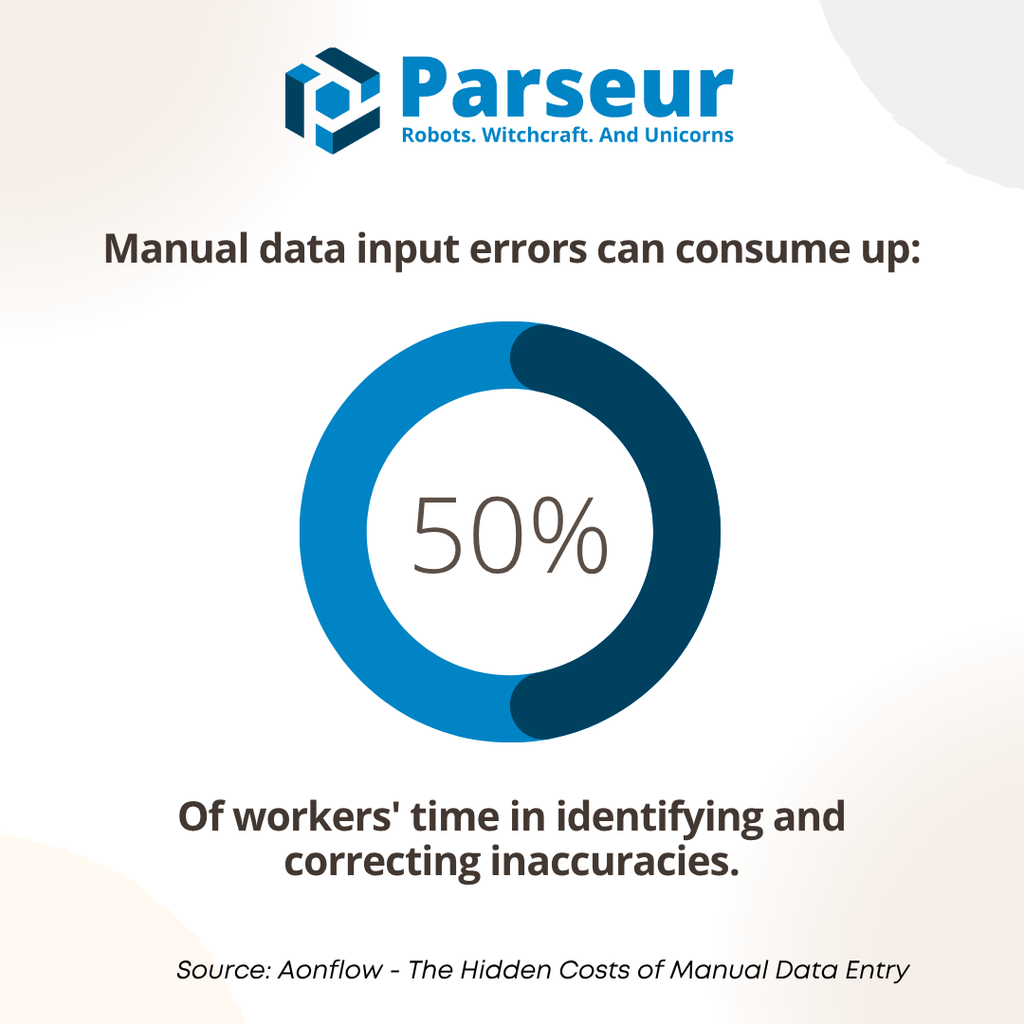
- The 1-10-100 rule from Magellan Solutions suggests that the cost to correct a data entry error increases exponentially: $1 to prevent, $10 to correct during validation, and $100 to correct after analysis.
- CloudHQ stated that 30% of accounting professionals admitted to inputting data incorrectly at their firm.
- Studies from Conexiom have found that when performing data entry tasks, humans can achieve an accuracy rate of around 95% for simple spreadsheets. However, this rate can drop, and the chance of a processing error increases to nearly 100% as complexity rises.
How Automation Improves Accuracy (and Reduces Human Errors)
- According to Managed Outsource Solutions, automation technologies such as AI, OCR, and machine learning are projected to drastically reduce error rates by enabling real-time data validation and correction.
- Gitnux reported that automating workflows can reduce errors by 70%, leading to more reliable data handling.
Real World Example
Louis Balla, Vice President of Sales & Partner at Nuage, slashed 40 weekly hours of manual email data entry down to 6 hours, eliminated costly shipping errors, and unlocked a $74,800 annual savings while boosting same-day case resolution to drive a 15% uptick in customer retention.
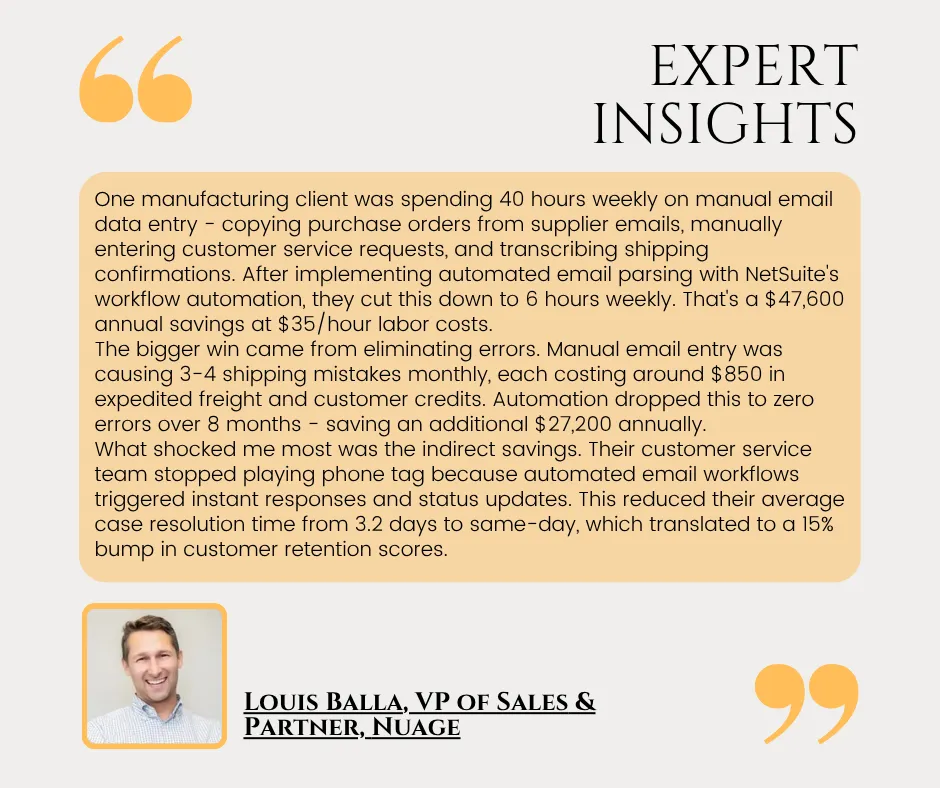
Cost of Manual Email Processing vs the ROI of Automation
Automation ROI: What the Numbers Say?
Productivity and cost are closely linked; this section highlights key statistics that demonstrate how automation, particularly with AI parsing, can reduce manual effort and lower operational costs.
- Perfect Data Entry reported that businesses implementing data entry automation experience overall productivity gains of up to 25%, as internal teams can shift their focus from repetitive administrative work to core business activities.
- Companies that automate data entry typically achieve cost savings of 20–30% compared to maintaining in-house manual data entry teams. These savings come from reduced labor, overhead, recruitment, and training costs, as stated by Perfect Data Entry.
- According to HubSpot, a 2024 sales survey found that sales representatives save approximately 2 hours and 15 minutes per day by utilizing automation tools for routine tasks, such as data entry and scheduling.
- American Express reported that automating accounts payable and payment processes frees roughly 9.9 hours per week (~500 hours per year) of clerical work.
- In practice, approximately 51% of office workers report spending at least 2 hours per day on manual repetitive tasks, according to Formstack.
- Automation greatly improves accuracy. In one study from Ringy, 34% of organizations saw fewer data-entry errors after switching to automated capture.

- McKinsey reports that automating processes can cut operational costs by up to ~30%
- Surveys from Software Oasis show businesses often achieve 10–50% reductions in process costs by eliminating manual tasks.
- A study by Formstack found that the average company saves around $46,000 per year through workflow automation.
- A report from Software Oasis revealed that robotic process automation (RPA) projects typically deliver a 30–200% return on investment (ROI) within the first year.
- According to Flowforma, one industry report found 78% of firms achieve payback within six months of deploying new automation solutions.
- A case study from Symtrax showed a 290% return on investment (ROI) just one year after automating invoice processing.
- 90% reduction in processing time for financial tasks (e.g., invoice processing dropped from 15 days to 1.5 days) as reported by NumberAnalytics.
- McKinsey estimates that 60% of employees could save 30% of their time with workflow automation.
- Vena Solutions sees that 82% of sales teams reclaim time for client relationships through automation, boosting productivity.
- 75% faster process deployment reported by Flowforma, from companies using digital workflow tools.
When Zapier set out to infuse its automation platform with AI, they faced a classic scaling challenge: how to roll out powerful, machine-learning–driven features without disrupting the millions of workflows their customers rely on every day. In this behind-the-scenes look, Zapier’s engineering and product teams reveal how they designed a gradual AI adoption strategy combining feature flags, user cohorts, and real-time feedback loops to deliver intelligent suggestions and automations safely, learn from early users, and iterate rapidly at global scale.
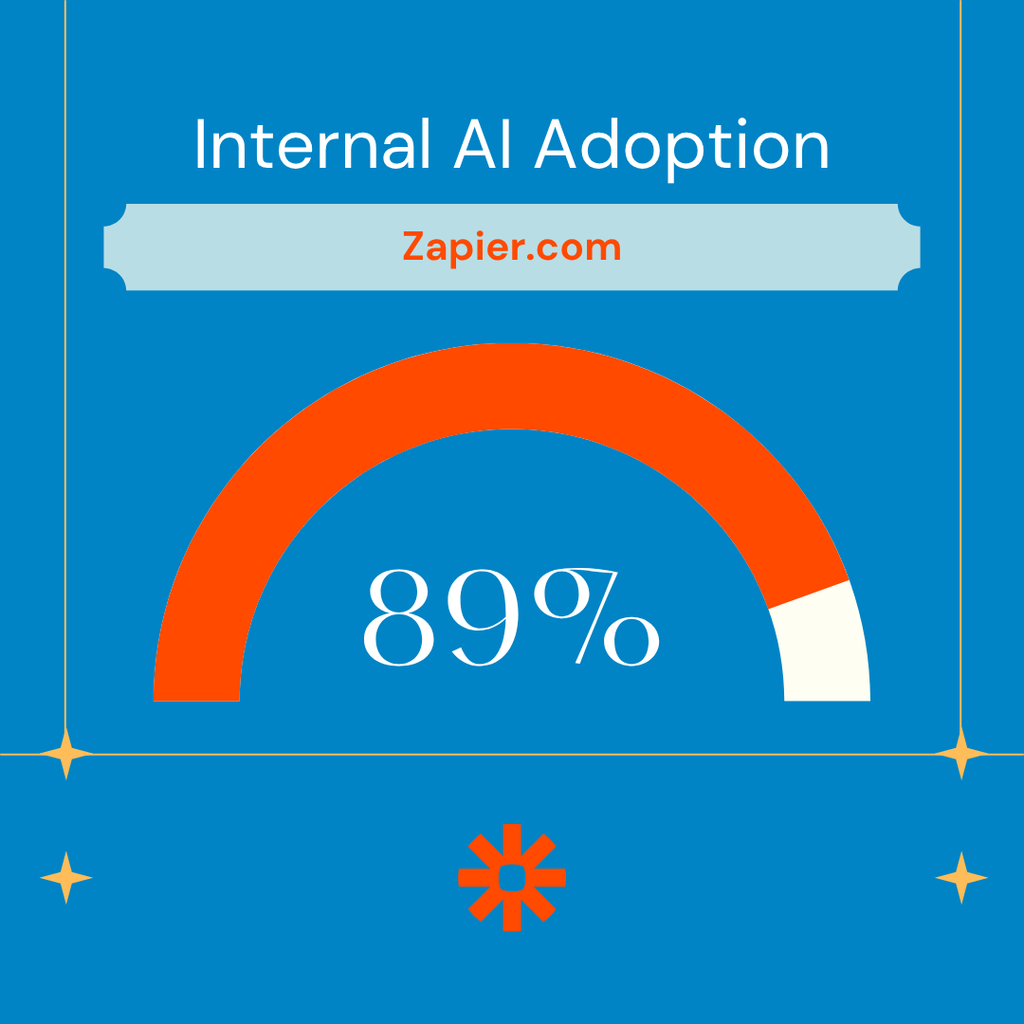
- NumberAnalytics stated that 70% average reduction in processing costs for finance back-office operations, with some cases reaching 80%
- A Viridem study found that 30–50% lower operational costs in administrative functions (e.g., document management, payroll).
- A 90% decrease in human errors for administrative tasks, resulting in a reduction of rework costs, as reported by Viridem.
- A study from BestPack revealed that 100% immediate deduction for automation investments (e.g., machinery) can accelerate ROI.
- 240% ROI achieved by businesses using robotic process automation (RPA), recouping costs in 6–9 months, as reported by Ardem.
- According to Integra, 94% of retailers prioritize automation for inventory management, reducing stockouts by 40%
Real World Example
Mike Khorev, Growth Advisor, demonstrates how automating email data entry for a high-volume client boosted productivity by 25%, slashed manual effort by over 70%, and turned tedious tasks into strategic opportunities.
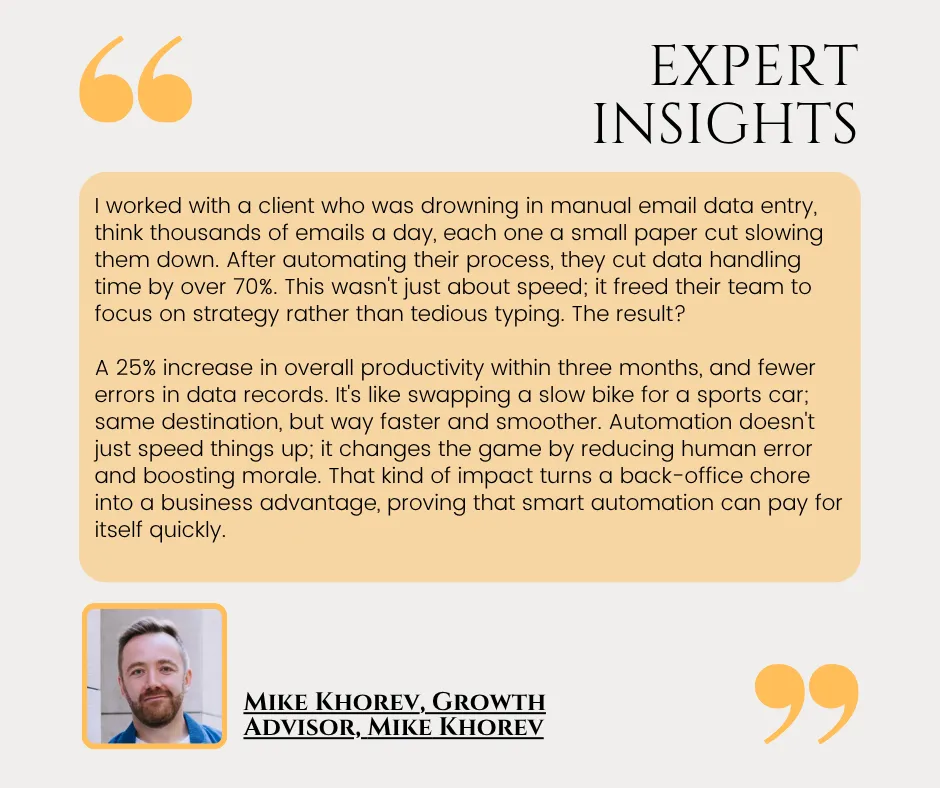
Industry Trends and Adoption
As businesses face increasing pressure to do more with less, 2026 is proving to be a pivotal year. Manual email data entry is giving way to smarter, automated solutions that drive efficiency, accuracy, and long-term growth.
2026 Trends
- A study from Gartner found that 90% of large enterprises now prioritize hyperautomation (RPA + AI + process mining) to break silos, with 30% automating >50% of operations.
- A study by Vena Solutions stated that IT teams report 93% higher productivity with AI-augmented workflows.
- 73% document processing automated, reducing turnaround from 48 hours to <1sec as reported by Vena Solutions.
- According to Kissflow, 73% of IT leaders confirm that manual processes waste between 10% and 50% of employee time.
- As stated by Kissflow, 68% of employees face unmanageable workloads due to manual processes, increasing burnout risk
- Automated emails generate 37% of all email-driven sales despite comprising only 2% of sent emails, according to Omnisend.
- Virfice reported that email marketing ROI hits $42 for every $1 spent—the highest of any digital channel.
Future Outlooks
- According to Exploding Topics, 65% of data processing tasks are expected to be fully automated by 2027.
- As stated by Blueprism, bias in autonomous systems will drive demand for AI ethics frameworks, reducing ethical incidents by 40% by 2028
- Valued at $1.2 billion in 2024, the market is projected to reach $3.5 billion by 2033, growing at a compound annual growth rate (CAGR) of 12.5%. The increasing need for efficient data extraction from emails across various industries drives this growth. Verified Market Reports reported this.
- Mediabrief study shows that the global market is expected to increase from $2.9 billion in 2020 to $6.6 billion by 2026, highlighting the expanding use of automated tools in marketing strategies, including email campaigns.
- Organizations are focusing on process intelligence and optimization, with a growing need for data-driven approaches.
- AI has the potential to contribute up to $15.7 trillion to the global economy by 2030, with significant boosts in GDP for local economies.
Real World Example
Gregg Kell, President of Kell Solutions, underscores how AI parsing has evolved from basic OCR to nuanced context-aware workflows automatically identifying service intents, extracting critical details, and prioritizing urgent issues like “lower back pain” without manual oversight.
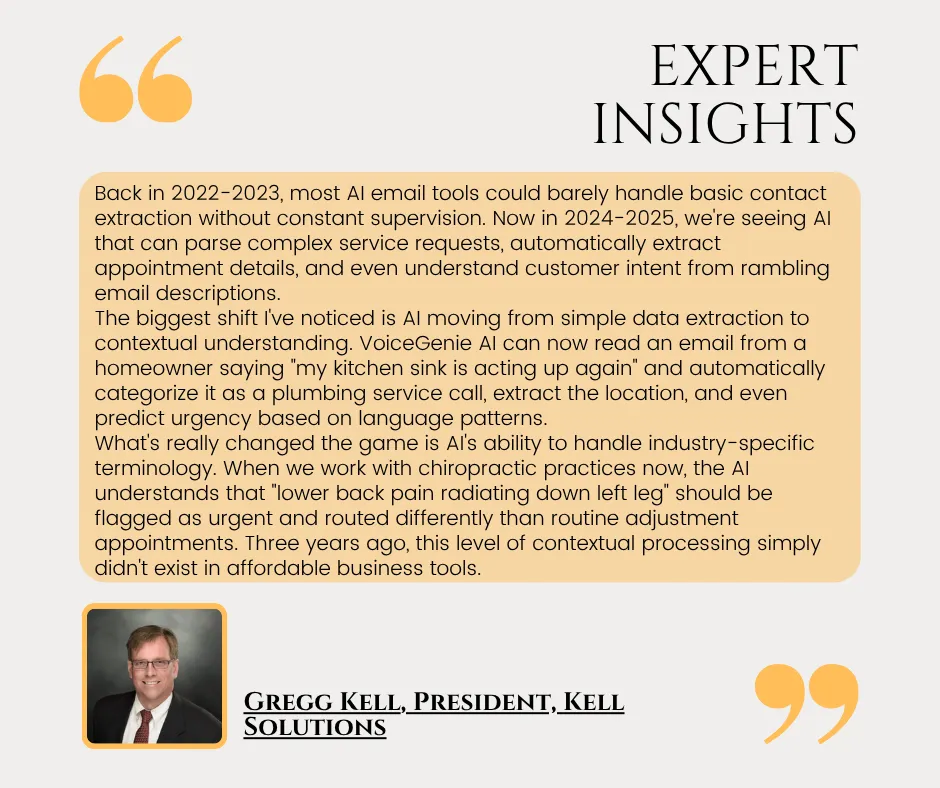
Why email data entry automation isn’t optional in 2026?
The numbers make it clear: manual email data entry is draining valuable time, increasing the risk of costly errors, and holding back productivity. In contrast, automation can reduce repetitive work by up to 80%, decrease error rates by 70–90%, and deliver an ROI of up to 240% within a year.

Whether you’re in sales, finance, healthcare, or operations, automating email workflows with tools like an AI-powered email parser isn’t just a modern convenience; it’s becoming a competitive necessity. Companies that adopt automation are regaining thousands of hours annually, boosting productivity by double digits and significantly improving data accuracy.
What would a 40% productivity boost mean for your business? The data shows it’s within reach.
Discover how to automate your email workflows with Parseur.
Global Shift Toward Email Parsing: Labor Cost, Automation, and the Push for Efficiency
Email parsing adoption is accelerating worldwide, but the pace and motivation differ significantly by region. While automation is often driven by cost efficiency, in many cases, it's also about scalability, speed, and the need to reduce reliance on manual, error-prone workflows.
At Parseur, internal customer data confirms that the adoption of automated email parsing is most concentrated in high-labor-cost economies, particularly the United States and Western Europe, where operational efficiency is critical and manual data entry is no longer sustainable.
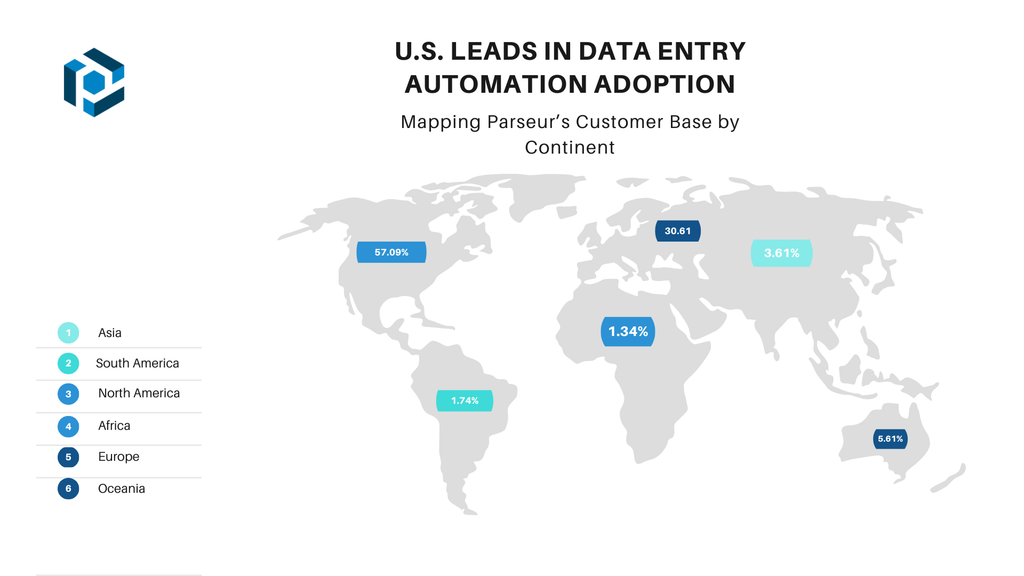
Today, the United States leads the world in data-entry automation, investing more heavily in this space than any other region. At Parseur, roughly 50% of our customers are based in the US, followed by about 30% in Europe. The remaining 20% are spread across other geos, with Africa closing the march. - Sylvestre Dupont, Co-Founder.
These figures illustrate a clear trend: high-income economies are leading the adoption of email parsers, mainly due to the unsustainable cost of manual administrative labor. In regions where average labor costs exceed $40–$50 per hour (e.g., the U.S., Switzerland, Germany), automating data entry from emails, invoices, and documents is not a convenience — it's a necessity.
Meanwhile, regions like Southeast Asia and Latin America are beginning to adopt parsing solutions not solely for cost savings, but to achieve scalability without the need to increase headcount linearly. As digital infrastructure improves globally, we anticipate accelerated adoption in these areas over the next two to three years.
Appendix - Voices from the Industry
Over 25+ professionals from finance, SaaS, logistics, and operations shared how email automation has changed their workflows.
From what I've seen, companies that switch to email data entry automation typically cut related costs by 40 to 60 percent, depending on the volume and complexity of their emails. The time saved often translates into faster response times and improved customer experience, which, in my opinion, has a more lasting value than the immediate financial savings. Having been part of projects where automation replaced manual entry, I can say the investment pays off quickly and scales well as the business grows. - Paul DeMott, Chief Technology Officer, Helium SEO
After implementing AI-powered email parsing tools, we reduced that workload to just 3 hours of oversight weekly. The real kicker was the 40% increase in lead response time because automation eliminated the human bottleneck entirely. The ROI becomes even more dramatic when you factor in accuracy improvements. Manual data entry typically has 3-5% error rates, while automated systems run closer to 0.1% - those errors cost businesses an average of $3,000 per incident in my experience.
What most people miss is the scalability factor. Manual processes break down completely during busy periods, but automated email data entry handles 10x the volume without additional costs. - Rodney Moreland, Founder, Celestial Digital Services
We implemented AI-driven email segmentation that automatically categorized customer emails by purchase behavior and extracted key data points. The system tagged VIP customers, flagged compliance-related communications, and auto-populated customer profiles with purchase preferences. Within three months, their email open rates jumped 40% and conversions increased 2.5x. The result? They went from 12 hours of manual work weekly to about 2 hours of quality control, and their email marketing ROI hit 131,884%. That's not a typo - proper automation in email marketing can be absolutely transformative when implemented correctly. - Stephen Gold, Business Owner, The Gold Standard
We had a client school that was manually entering donor information from hundreds of thank-you emails and pledge confirmations into their database. Their development office was spending 12+ hours weekly on this data entry, and they were missing follow-up opportunities because important donor communications got buried in inboxes.
When we integrated automated email parsing into our donor recognition platform, their data entry time dropped to under 2 hours per week. More importantly, their donor retention jumped 25% because every email interaction was automatically logged and triggered appropriate follow-up sequences. That automation helped them scale from $800K to $2.1M in annual giving over 18 months. - Chase Mckee, Founder & CEO, Rocket Alumni Solutions - Digital Record Board
At Edstellar, the shift we've observed is not just about better accuracy, it's about context-awareness. For instance, modern AI doesn't just pull names and dates from an email; it understands urgency, sentiment, and even implied actions. A 2026 report from PwC noted that enterprises using AI-driven email parsing saw a 68% reduction in processing time and a 45% improvement in downstream task automation. What that tells me is this AI is no longer supporting back-office functions; it's driving front-line performance. And the businesses leveraging this capability are operating with significantly more speed and intelligence than those still relying on manual or legacy systems. - Arvind Rongala, CEO, Edstellar
We implemented automated email parsing that categorized inquiries by service type and extracted key project data directly into their CRM. Within 60 days, their response time dropped from 2-3 days to same-day responses. More importantly, they converted 34% more qualified leads because prospects weren't waiting around for callbacks. - Tony Crisp, CEO & Co-Founder, CRISPx
The biggest shift is moving from rule-based extraction to contextual understanding. Instead of programming "if email contains $ symbol, extract number," AI now reads emails like humans do and makes judgment calls about what data actually matters for business decisions. - Ryan T. Murphy, Sales Operations Manager, Upfront Operations
How has the use of AI evolved? Early AI tools were clunky, good at pulling names, but blind to nuance. Today, it's a different game. Our AI platform is trained on 40M+ outbound email interactions. It reads signals, sentiment, and intent and flags high-interest replies, scores them, enriches instantly. That's making it finally useful at scale. Is manual data entry obsolete? Yes. Copy-pasting titles and URLs isn't selling, its admin. For most workflows, it's a waste. If you're still doing it in 2026, you're falling behind. The tech exists, the ROI is proven, and the reps are too valuable to be stuck doing tasks a browser extension can handle in seconds.- Vito Vishnepolsky, Founder and Director, Martal Group
At Invensis Learning, we've observed companies cut manual data entry time by as much as 70-80% using automation tools powered by AI and NLP. According to recent 2026 research by Deloitte, organizations adopting email automation save an average of $4 million annually in labor costs alone. But beyond the financials, the real value lies in how automation reduces human error by up to 90% and accelerates workflows that would otherwise bottleneck service delivery or operations. - Arvind Rongala, CEO, Invensis Learning
The biggest shift I've seen is AI moving from simple data extraction to intelligent data enrichment. Instead of just pulling out email addresses and phone numbers, modern AI can identify customer sentiment, predict churn risk, and automatically tag leads by qualification level. At SiteRank, this has reduced our client onboarding data prep from 8 hours to under 45 minutes.- Craig Flickinger, CEO, SiteRank
As volumes grow, AI doesn't slow down or lose focus. Human teams can shift to higher-value work. The key is tight integration with existing tools and constant feedback to refine model accuracy. Businesses that treat AI as a teammate, not a replacement, win faster and make fewer mistakes. The shift is already underway. Those still using manual entry face higher costs and slower cycles.- Alec Loeb, VP of Growth Marketing, EcoATM
We had a manufacturing client in Columbus who was drowning in vendor invoices coming through email. Their AP team was manually copying data from 200+ weekly vendor emails into QuickBooks, taking 12 hours weekly and creating constant bottlenecks. We implemented Zapier integration between their email system and QuickBooks that automatically extracted invoice data and populated their accounting system. Within 90 days, their invoice processing time dropped from 12 hours to 2 hours weekly, and their vendor payment accuracy improved from 87% to 99.2%. The measurable impact hit their bottom line hard - they avoided $8,400 in late payment penalties that quarter alone. More importantly, their AP person could focus on vendor relationship management instead of data entry drudgery. - Steve Payerle, President, Next Level Technologies
For HVAC companies like ours handling 24/7 emergency services, I'd estimate realistic savings of 60-75% on email processing time, plus another 10-15% revenue boost from improved response speeds. The ROI hits within 3-4 months for most service businesses with decent email volume.- Christy Robinson, Director of Marketing, Comfort Temp
In my own business, I automated lead qualification from website contact forms and email inquiries. Instead of manually sorting through 50+ daily emails to identify serious prospects, the system now automatically scores leads and routes high-value ones directly to my calendar. This freed up 2 hours daily that I now spend on actual design work, increasing my project capacity by 30%.- Athena Kavis, Web Developer & Founder, Quix Sites
For most service businesses processing 50+ inquiry emails weekly, automation typically saves 10-20 hours of manual work. That translates to $300-800 monthly savings in labor costs, plus the revenue boost from faster response times - we consistently see 25-40% improvements in inquiry-to-appointment conversion rates when businesses move from manual to automated email processing.- Raymond Strippy, Founder, Growth Catalyst Crew
At FLATS, we had hundreds of prospect inquiries flooding our leasing teams' inboxes daily across our Chicago, San Diego, Minneapolis, and Vancouver portfolio. Our staff was manually copying prospect details, tour requests, and follow-up notes into our CRM system, eating up 15+ hours weekly per property.
We implemented automated email parsing through our CRM integration that pulled prospect information directly from inquiry emails and auto-populated lead records. This cut manual data entry time by 80% and eliminated the lag between inquiry and first contact. The business impact was immediate - we saw a 25% increase in qualified leads and achieved 25% faster lease-up times across our portfolio. More importantly, our teams could focus on actual prospect engagement instead of administrative work, which directly contributed to our 15% reduction in cost per lease. - Gunnar Blakeway-Walen TBT, Marketing Manager, The Bush Temple By Flats
We were manually copying lease data from landlord emails into spreadsheets for market analysis—easily 6+ hours weekly of mind-numbing data entry. After implementing our AI deal analyzer that automatically extracts key terms from email attachments (rent rates, escalations, tenant allowances), that dropped to under 30 minutes of review time.
The business impact hit immediately in our lease negotiations. Our AI now catches escalation clauses and auto-renewal traps with 98% accuracy versus the 15% error rate from manual reviews. This prevented three clients from inadvertent 5-year auto-renewals that would've cost them $340K combined. Most importantly, eliminating email data entry freed up time for actual revenue-generating activities. We increased our tenant-side renewals by 35% and shortened negotiation cycles from 45 to 28 days because we could focus on strategy instead of data copying.- Brett Sherman, Real Estate Broker, Signature Realty
We had customers - especially our baby boomer clientele - sending product inquiries, shipping questions, and custom order requests through multiple email channels. My team was manually copying customer details, order specifications, and follow-up notes into our CRM system, eating up 15+ hours weekly.
When we automated the email parsing for customer inquiries, something unexpected happened beyond time savings. The business impact was immediate - our repeat customer rate increased 30% because every interaction was logged perfectly. - Nino Russo Alesi, Acting CEO, Rattan Imports
At AZ IV Medics, we were drowning in manual email processing - intake forms, insurance verifications, and appointment confirmations were eating up 15+ hours weekly from our medical staff. Every patient inquiry email required someone to manually extract information and input it into our scheduling system.Our administrative overhead dropped from 15 hours to about 3 hours per week, but the real impact was speed - our response time went from 4-6 hours to under 30 minutes. Patient conversion rates jumped 40% because we could respond while competitors were still manually processing emails. This automation was actually one of the key factors that helped us scale revenue from $3 million to over $12 million annually - we could handle 3x the patient volume without proportionally increasing administrative staff. - Joseph Lopez nc, Owner, Number 2 Club
The real savings came during our busy seasons when broken garage doors spike. Instead of our team manually sorting through 50+ daily service emails, automation now categorizes emergency calls, warranty issues, and routine maintenance requests instantly. We went from 2-day response times to same-day service, which directly increased our revenue by keeping customers who would have called competitors.- Preston Hiller, Business Owner, Gecko Garage Door Repair Service
For service companies like ours, I'd estimate realistic savings of $15,000-25,000 annually just from labor reduction, plus another 15-20% revenue boost from faster customer response times. The key is starting with your highest-volume, most repetitive email processes first.- Courtney Zalesak, Vice President, Malek Service Company
One healthcare client I worked with was manually processing 200+ patient inquiry emails daily - copying contact info, appointment requests, and insurance details into their system. This was eating up 4 hours of staff time at $25/hour, costing them $500 daily or roughly $130K annually just in labor. We implemented Google Tag Manager with automated email parsing that fed directly into their patient management system. The time savings hit 85% immediately - from 4 hours down to 30 minutes of oversight daily. That translated to $110K in annual labor savings, plus they could handle 40% more patient inquiries without hiring additional staff. - Milton Brown, Owner, Multi Touch Marketing
The business impact was immediate and measurable. Client complaints decreased by over 80% because nothing fell through the cracks anymore, and their business valuation increased by 30% within six months. The automated email workflows didn't just save time—they created the reliable systems that made the company actually sellable.
What surprised me most was how much customer satisfaction improved when emails got processed consistently instead of getting buried in someone's inbox during busy periods.- Keaton Kay, Founder & CEO, Scale Lite
Here's the kicker, nobody talks about - automated email data entry revealed patterns we never spotted manually. Our system flagged that prospects mentioning "AI" or "automation" in their initial emails had 3x higher lifetime value, so we started prioritizing those leads differently and saw our average deal size increase 34%.- REBL Risty, CEO, REBL Marketing
What really drove performance was the accuracy improvement. Manual entry had about 12% error rates in donor contact information, which meant failed follow-ups and lost recurring donations. The automated system reduced errors to under 2%, directly boosting their donor retention by 34% over three months.- Mahir Iskender, Founder, KNDR
We had one client spending 15 hours weekly manually copying email details into their CRM. After implementing the native Dynamics-Outlook integration, that dropped to under 2 hours for review and quality control. That's a 87% time reduction, which translated to roughly $25,000 annually in labor savings for just 5 staff members. - Warren Davies, Director & Owner, BeyondCRM
One manufacturing client was spending 15 hours weekly having staff manually enter prospect emails into their CRM. After implementing our Reveal Revenue system with automated email nurturing, they cut that to under 2 hours while simultaneously increasing lead follow-up speed by 400%. The time savings alone freed up almost two full workdays per week. - Kiel Tredrea, President & CMO, RED27Creative
This franchise owner was manually sorting through 200+ daily emails - customer inquiries, scheduling requests, vendor communications, and corporate updates. Their admin was spending 4 hours daily just categorizing and entering this data into their CRM. We set up an automated system that identifies email types, extracts key details (service type, urgency, contact info), and routes everything to the right team members. The results were immediate: lead response time dropped from 6 hours to under 30 minutes, which increased their booking conversion rate by 34%. More importantly, that admin could focus on actual customer service instead of data entry, leading to a 28% boost in customer satisfaction scores. - Bernadette King, CEO, King Digital Pros
Last updated on




